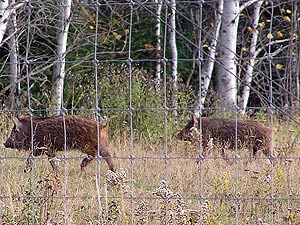|
Audio
Photos
More from MPR
Resources
Respond to this story
|
Douglas County, Wis. — Greg Kessler is looking at an animal track in the mud. There's lots of tracks here. He finds them sunk deep into a marshy field, on a mucky foot path, and around a bunch of shallow brown puddles. The footprints look like deer tracks. But Kessler says they're all from pigs.
"Here's that little rounded piece," says Kessler, pointing to the imprint of the pigs' dew claws which stick out on either side of its hooves. "Until you look at lots of them, I think myself, and most other hunters never knew what they were looking at."
Kessler is a biologist with the Wisconsin Department of Natural Resources. He's walking a meandering trail through a thicket of dense grass and five-foot high brush. It's ideal habitat for deer, and, as it turns out, for pigs too. The muddy holes are wallows where the pigs roll around in warm weather.
These pigs are believed the offspring of a few escapees from a nearby wild game farm. They're not cute little pink porkers -- they're more like the dark and menacing Russian boar. They're smart, fast, and aggressive. John Loustari first spotted dark black pigs on his property two years ago.
"First when I saw them down there, I thought they were a bear," Loustari says. "I got fairly close to them. And then the little ones, there were about 11 of them. They were more of a brownish color."
At first a novelty, Loustari says the porkers quickly became a pest.
"We've known they've been around here," says Loustari. "But a year ago I didn't think there was much more than maybe a dozen or so scattered all over. And all of the sudden, you know, about August I went down to the lake there and saw 13 of them. And other people that drive down there have been seeing whole bunches of them."
Conservation Warden Brad Biser is along. He almost brought his rifle, just in case.
"We felt up here that they wouldn't survive with the winter conditions," Biser says. "Although the winter up here is much more temperate along the south shore of Lake Superior, more so than say down into the Brule/Iron River (Wisconsin) area."
DNR employees have been taking turns in a pig stand here. It's actually a portable deer stand, over a rather rancid pile of corn.
Armed with high-powered rifles, they've been picking off hungry pigs, one after another. Others are hunting the pigs. In Wisconsin, feral pigs are fair game to anyone with a small game license. About 60 have been taken here since August. But there's more out there.
Biologist Greg Kessler says pigs can wreak havoc on nature. And they'll eat just about anything. "Our concern is their tendency to cause damage to the environment," says Kessler. "They can degrade vegetation by rooting and creating wallows and digging up vegetation. They can impact song birds and other animals. They will eat small mammals if they can catch them. Ground-nesting birds -- they've been known to be pretty hard on bird populations. Even in some studies they've implicated them as far as preying on deer fawns."
They're especially unwelcome in farm country, where they can kill young livestock and destroy crops. The pigs also can carry diseases dangerous to people, pets, and livestock.
Wild pigs are a relative newcomer to Wisconsin. They haven't been reported in Minnesota. But Kessler says they're well established farther south.
"Southern United States has been dealing with these things for decades," says Kessler. "In the United States there's estimated to be four million feral hogs right now. And virtually everywhere that they have been let get established, they are almost impossible to get rid of."
Pigs are prolific. They can have four litters a year, with anywhere from four to 12 piglets at a time. Experts say you have to kill 75 percent of the pigs each year just to keep the population in check.
So in Wisconsin, it's open season on feral pigs. There's no bag limit and no hunting restrictions. With help from landowners, hunters and DNR sharpshooters, they hope to move Douglas County's pigs out of the wild and into the freezer.








